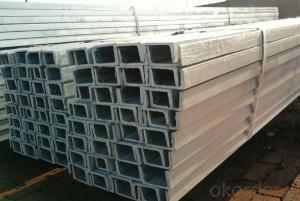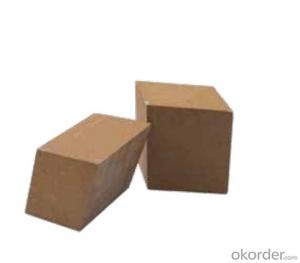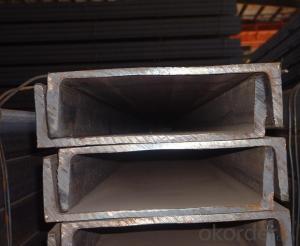JIS SS400 Steel Channel with High Quality 100mm
- Loading Port:
- Tianjin
- Payment Terms:
- TT OR LC
- Min Order Qty:
- 25 m.t
- Supply Capability:
- 10000 m.t/month
OKorder Service Pledge
OKorder Financial Service
You Might Also Like
JIS SS400 Steel Channel with High Quality 100mm
Product Description:
Standard: JIS
Material: SS400
Length: 6m, 12m
Size:
Size (mm) | Mass (Kg/m) |
100*50*3.8 | 7.30 |
100*50*5.0 | 9.36 |
Package & Delivery of JIS SS400 Steel Channel with High Quality 100mm:
1.The hot rolled channel steel will be packed in bundle with steel wire at each end of every bundle and color marking in order to help the customer to recognize his goods more easily at sight.
2. And the hot rolled channel steel could be loaded into 20ft or 40ft container, or by bulk cargo.If the weight of each bundle reaches more than 3.5 mt, the loading by break bulk cargo should be choosed.When the weight of each bundle reaches less than 3mt, the loading by container should be choosed.
3.As for the transportaion from mill to loading port, the truck will be usually used. And the maximum quantity for each truck is 40mt.
4.All in all, we could do in accordance with customer's request.
Production Flow of JIS SS400 Steel Channel with High Quality 100mm:
1.The steel billet shall be heated in the high temperature furnace.
2. The heated steel billet shall be rolled five to nine times with the aim of shaping the general figure of steel u channel.
3. The rolled steel channel should be put onto the cooling bed to make the temperature low.
4. The JIS Channel should be straighted on the straightener.
5. The straighted steel u channel will be cut into meters by saw, as per customer's requirements.
6. At the last part of production, the channel steel must be tested in order to confirm that the finished products are completely free from crack, pore, slag, scab or fold on the surface.
FAQ:
Q1: Why buy Materials & Equipment from OKorder.com?
A1: All products offered byOKorder.com are carefully selected from China's most reliable manufacturing enterprises. Through its ISO certifications, OKorder.com adheres to the highest standards and a commitment to supply chain safety and customer satisfaction.
Q2: How do we guarantee the quality of our products?
A2: We have established an advanced quality management system which conducts strict quality tests at every step, from raw materials to the final product. At the same time, we provide extensive follow-up service assurances as required.
Q3: How soon can we receive the product after purchase?
A3: Within three days of placing an order, we will arrange production. The shipping date is dependent upon the quatity, how many sizes you want and the plan of production, but is typically 1 month to 2 month days from the beginning of production.
Images of JIS SS400 Steel Channel with High Quality 100mm:


*If you would like to get our price, please inform us the size, standard/material and quantity. Thank you very much for your attention.
- Q:How do steel channels perform in high-snow load regions?
- Steel channels are an excellent choice for construction in high-snow load regions due to their high strength and durability. They are designed to withstand heavy loads, including the weight of accumulated snow on roofs and structures. The structural integrity of steel channels allows them to distribute the weight evenly, preventing any excessive stress or strain. Additionally, steel channels have a high resistance to corrosion, ensuring their longevity even in harsh weather conditions. Due to their performance and reliability, steel channels are widely used in buildings and infrastructure in high-snow load regions, providing stability and safety in these areas.
- Q:How do steel channels contribute to the overall flexibility of a structure?
- The overall flexibility of a structure is improved through the utilization of steel channels in multiple ways. To begin with, they contribute to the structure's stability by offering extra support and reinforcement, enabling the more efficient distribution of loads and forces. This results in the prevention of excessive deflections and deformations. What's more, steel channels possess a high degree of versatility and can be easily customized and adjusted to meet specific project requirements. Their open shape allows for the insertion of other structural elements, like beams or columns, which further enhances the structure's flexibility. This adaptability permits engineers to design structures with varying span lengths and load capacities, making them suitable for a wide range of applications. In addition, steel channels possess a high strength-to-weight ratio, meaning they can withstand significant loads while remaining relatively lightweight. This characteristic enables the construction of more flexible and cost-effective structures, as the weight of the channels does not excessively contribute to the overall load on the structure. Furthermore, steel channels can be easily interconnected and joined together using bolts, welding, or other methods. This simplifies the construction process and allows for the inclusion of different design elements, such as cantilevers or bracing systems, which can further enhance the structure's flexibility and overall performance. In conclusion, steel channels play a vital role in enhancing the flexibility of structures by providing additional support, adaptability, and strength. Their efficient load distribution, ability to accommodate various design requirements, and capacity to withstand significant forces make them a valuable component in the construction industry.
- Q:Can steel channels be used in temporary structures?
- Yes, steel channels can be used in temporary structures. Steel channels are strong and durable, making them a suitable choice for temporary structures that require stability and support. Additionally, steel channels can be easily assembled and disassembled, making them convenient for temporary structures that may need to be relocated or dismantled in the future.
- Q:How do steel channels resist impact and vibrations?
- Steel channels exhibit resistance to impact and vibrations due to their inherent properties and design features. To begin with, steel possesses exceptional strength and durability, rendering it highly impervious to impact. It possesses a high modulus of elasticity, enabling it to absorb and disperse energy from an impact force. Consequently, when subjected to external forces, a steel channel can undergo elastic deformation without enduring permanent deformation or fracture, thereby mitigating the impact's impact. Moreover, steel channels are frequently engineered with specific shapes and profiles that augment their resistance to impact and vibrations. The channel's geometry, such as its flanges and web, facilitates the even distribution of force throughout the structure. This structural arrangement heightens the channel's rigidity and stiffness, minimizing the potential for flexing or bending when confronted with impact or vibration. Furthermore, steel channels have the capacity to be fortified with supplementary components like bracing or stiffeners. These reinforcements further bolster the channel's ability to withstand impact and vibrations by amplifying its overall strength and stability. Additionally, steel channels can be constructed or treated to improve their impact and vibration resistance properties. Techniques such as heat treatment or alloying can enhance the steel's hardness, toughness, and resilience, thereby rendering it more impervious to damage caused by impact and vibrations. In conclusion, steel channels effectively thwart impacts and vibrations by leveraging a combination of their intrinsic properties, design characteristics, and supplementary fortifications. Their strength, durability, geometry, and optional treatments render them exceedingly dependable and efficacious in resisting external forces and minimizing the deleterious effects of impacts and vibrations.
- Q:What are the different methods for reinforcing steel channels?
- There are several methods for reinforcing steel channels, depending on the specific requirements and applications. Some of the common methods include: 1. Welding: Welding is a widely used method for reinforcing steel channels. It involves attaching additional steel plates or bars to the existing channel using high heat generated by an electric arc. This method provides a strong bond and ensures structural integrity. 2. Bolting: Bolting is another method used to reinforce steel channels. It involves attaching additional steel plates or bars to the channel using bolts and nuts. This method is relatively easier to implement and allows for easy removal or adjustment if required. 3. Adhesive bonding: Adhesive bonding is a technique that involves using industrial-grade adhesives to bond additional steel plates or bars to the steel channel. This method offers a strong bond and is often used in applications where welding or bolting may not be feasible or desired. 4. Fiber reinforced polymers (FRP): FRP composites, such as carbon fiber or fiberglass, can be used to reinforce steel channels. These materials are lightweight, high-strength, and corrosion-resistant, making them ideal for strengthening channels in corrosive environments or where weight is a concern. 5. Shotcreting: Shotcreting is a method that involves spraying a mixture of cement, sand, and reinforcing fibers onto the surface of the steel channel. This creates a layer of reinforced concrete that enhances the strength and durability of the channel. 6. Encasement: In some cases, steel channels may be reinforced by encasing them in concrete. This method involves pouring concrete around the channel, creating a composite structure that combines the strength of both materials. 7. Pre-stressing: Pre-stressing is a technique that involves applying tension to the steel channel before it is loaded. This can be done using pre-stressed steel strands or bars, which are anchored at the ends of the channel. The pre-stressing force helps to counteract the tensile forces that the channel may experience during use. It is important to note that the selection of the appropriate method for reinforcing steel channels depends on factors such as the load requirements, environmental conditions, cost, and feasibility. Consulting with a structural engineer or expert is recommended to ensure the chosen method meets the specific needs of the application.
- Q:Can steel channels be used for roof structures?
- Indeed, roof structures can utilize steel channels. Construction frequently incorporates steel channels due to their robustness and endurance. They offer support for the structure and can function as purlins or rafters within roof systems. Steel channels possess the capability to endure substantial burdens and contribute stability to the entire framework. Furthermore, their fabrication and installation are hassle-free, rendering them a favored option for roof construction. Moreover, steel channels exhibit resistance to fire, corrosion, and pests, establishing them as a dependable and enduring choice for roof structures.
- Q:Can steel channels be used in earthquake-resistant buildings?
- Yes, steel channels can be used in earthquake-resistant buildings. Steel channels are commonly used in the construction industry due to their high strength and durability. In earthquake-resistant buildings, it is important to have a structural system that can withstand the lateral forces generated during an earthquake. Steel channels can effectively distribute and dissipate these forces, making them a suitable choice for earthquake-resistant construction. Steel channels provide several advantages in earthquake-resistant buildings. Firstly, they have excellent load-bearing capacity, which allows them to support heavy loads and resist the forces exerted during an earthquake. Secondly, they have a high modulus of elasticity, meaning they can deform under stress and then return to their original shape once the stress is removed. This flexibility helps prevent brittle failure and allows the structure to absorb and dissipate energy during an earthquake. Additionally, steel channels have a high ductility, which is crucial in seismic design. Ductility refers to the ability of a material to undergo large deformations without breaking. During an earthquake, steel channels can absorb and dissipate energy by undergoing plastic deformation, reducing the overall damage to the structure. Furthermore, steel channels can be easily fabricated and installed, making them a cost-effective option for earthquake-resistant construction. They are also readily available in the market in various sizes and shapes, allowing for flexibility in design. However, it is important to note that the use of steel channels alone is not sufficient to ensure complete earthquake resistance. The overall structural design, including the connections, bracing systems, and foundation, should be carefully considered and designed by a qualified structural engineer to meet the specific seismic requirements of the region. Building codes and regulations also play a crucial role in ensuring the safety and resilience of earthquake-resistant buildings.
- Q:Are steel channels suitable for railway infrastructure?
- Steel channels are a suitable choice for railway infrastructure. They are widely used in the construction of railway tracks and other structures due to their strength, durability, and versatility. By providing structural support and stability, steel channels create solid foundations for railway tracks. In addition, they have excellent load-bearing capabilities, enabling them to withstand the weight and impact of passing trains. This makes them perfect for railway infrastructure as they can handle the constant stresses and strains caused by moving trains. Furthermore, steel channels are resistant to corrosion and weathering, which is essential for railway infrastructure exposed to various environmental conditions. They can endure extreme temperatures, moisture, and other external factors, resulting in a longer lifespan and reduced maintenance needs. Moreover, steel channels can be fabricated and installed in various shapes and sizes to meet the specific requirements of railway infrastructure. They can be easily customized to fit different track layouts, bridges, and other structures. This flexibility makes steel channels highly adaptable and suitable for a wide range of railway applications. In conclusion, steel channels offer numerous advantages, including strength, durability, corrosion resistance, and flexibility, making them highly suitable for railway infrastructure. They provide the necessary support and stability, withstand heavy loads, and ensure long-term performance, making them a reliable choice for railway construction and maintenance.
- Q:Can steel channels be used in multi-story buildings?
- Yes, steel channels can be used in multi-story buildings. Steel channels are commonly used for structural support in construction, including in multi-story buildings, due to their strength, durability, and ability to withstand heavy loads. They provide stability and support to the building's framework, contributing to its overall structural integrity.
- Q:Can steel channels be used in the agricultural manufacturing industry?
- Yes, steel channels can be used in the agricultural manufacturing industry. Steel channels are versatile and durable, making them suitable for various applications in agriculture, such as constructing farm equipment, machinery, and structures like barns and sheds.
1. Manufacturer Overview |
|
|---|---|
| Location | |
| Year Established | |
| Annual Output Value | |
| Main Markets | |
| Company Certifications | |
2. Manufacturer Certificates |
|
|---|---|
| a) Certification Name | |
| Range | |
| Reference | |
| Validity Period | |
3. Manufacturer Capability |
|
|---|---|
| a)Trade Capacity | |
| Nearest Port | |
| Export Percentage | |
| No.of Employees in Trade Department | |
| Language Spoken: | |
| b)Factory Information | |
| Factory Size: | |
| No. of Production Lines | |
| Contract Manufacturing | |
| Product Price Range | |
Send your message to us
JIS SS400 Steel Channel with High Quality 100mm
- Loading Port:
- Tianjin
- Payment Terms:
- TT OR LC
- Min Order Qty:
- 25 m.t
- Supply Capability:
- 10000 m.t/month
OKorder Service Pledge
OKorder Financial Service
Similar products
New products
Hot products
Related keywords





























